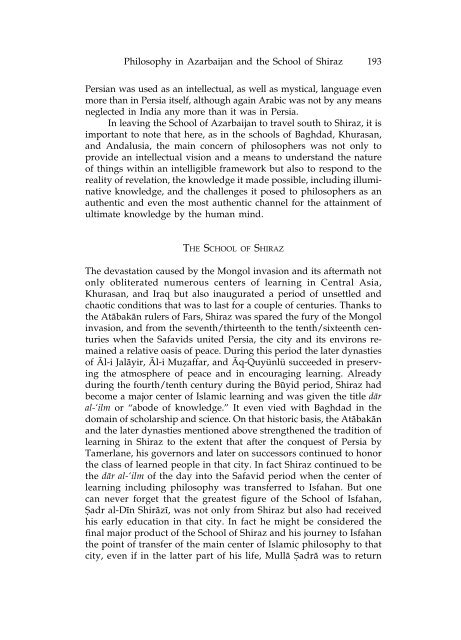Islamic Philosophy from Its Origin to the Present: Philosophy in the ...
Islamic Philosophy from Its Origin to the Present: Philosophy in the ...
Islamic Philosophy from Its Origin to the Present: Philosophy in the ...
You also want an ePaper? Increase the reach of your titles
YUMPU automatically turns print PDFs into web optimized ePapers that Google loves.
<strong>Philosophy</strong> <strong>in</strong> Azarbaijan and <strong>the</strong> School of Shiraz 193<br />
Persian was used as an <strong>in</strong>tellectual, as well as mystical, language even<br />
more than <strong>in</strong> Persia itself, although aga<strong>in</strong> Arabic was not by any means<br />
neglected <strong>in</strong> India any more than it was <strong>in</strong> Persia.<br />
In leav<strong>in</strong>g <strong>the</strong> School of Azarbaijan <strong>to</strong> travel south <strong>to</strong> Shiraz, it is<br />
important <strong>to</strong> note that here, as <strong>in</strong> <strong>the</strong> schools of Baghdad, Khurasan,<br />
and Andalusia, <strong>the</strong> ma<strong>in</strong> concern of philosophers was not only <strong>to</strong><br />
provide an <strong>in</strong>tellectual vision and a means <strong>to</strong> understand <strong>the</strong> nature<br />
of th<strong>in</strong>gs with<strong>in</strong> an <strong>in</strong>telligible framework but also <strong>to</strong> respond <strong>to</strong> <strong>the</strong><br />
reality of revelation, <strong>the</strong> knowledge it made possible, <strong>in</strong>clud<strong>in</strong>g illum<strong>in</strong>ative<br />
knowledge, and <strong>the</strong> challenges it posed <strong>to</strong> philosophers as an<br />
au<strong>the</strong>ntic and even <strong>the</strong> most au<strong>the</strong>ntic channel for <strong>the</strong> atta<strong>in</strong>ment of<br />
ultimate knowledge by <strong>the</strong> human m<strong>in</strong>d.<br />
THE SCHOOL OF SHIRAZ<br />
The devastation caused by <strong>the</strong> Mongol <strong>in</strong>vasion and its aftermath not<br />
only obliterated numerous centers of learn<strong>in</strong>g <strong>in</strong> Central Asia,<br />
Khurasan, and Iraq but also <strong>in</strong>augurated a period of unsettled and<br />
chaotic conditions that was <strong>to</strong> last for a couple of centuries. Thanks <strong>to</strong><br />
<strong>the</strong> Atåbakån rulers of Fars, Shiraz was spared <strong>the</strong> fury of <strong>the</strong> Mongol<br />
<strong>in</strong>vasion, and <strong>from</strong> <strong>the</strong> seventh/thirteenth <strong>to</strong> <strong>the</strong> tenth/sixteenth centuries<br />
when <strong>the</strong> Safavids united Persia, <strong>the</strong> city and its environs rema<strong>in</strong>ed<br />
a relative oasis of peace. Dur<strong>in</strong>g this period <strong>the</strong> later dynasties<br />
of ≈l-i Jalåyir, ≈l-i Muπaffar, and ≈q-Quyünlü succeeded <strong>in</strong> preserv<strong>in</strong>g<br />
<strong>the</strong> atmosphere of peace and <strong>in</strong> encourag<strong>in</strong>g learn<strong>in</strong>g. Already<br />
dur<strong>in</strong>g <strong>the</strong> fourth/tenth century dur<strong>in</strong>g <strong>the</strong> B¨yid period, Shiraz had<br />
become a major center of <strong>Islamic</strong> learn<strong>in</strong>g and was given <strong>the</strong> title dår<br />
al-‘ilm or “abode of knowledge.” It even vied with Baghdad <strong>in</strong> <strong>the</strong><br />
doma<strong>in</strong> of scholarship and science. On that his<strong>to</strong>ric basis, <strong>the</strong> Atåbakån<br />
and <strong>the</strong> later dynasties mentioned above streng<strong>the</strong>ned <strong>the</strong> tradition of<br />
learn<strong>in</strong>g <strong>in</strong> Shiraz <strong>to</strong> <strong>the</strong> extent that after <strong>the</strong> conquest of Persia by<br />
Tamerlane, his governors and later on successors cont<strong>in</strong>ued <strong>to</strong> honor<br />
<strong>the</strong> class of learned people <strong>in</strong> that city. In fact Shiraz cont<strong>in</strong>ued <strong>to</strong> be<br />
<strong>the</strong> dår al-‘ilm of <strong>the</strong> day <strong>in</strong><strong>to</strong> <strong>the</strong> Safavid period when <strong>the</strong> center of<br />
learn<strong>in</strong>g <strong>in</strong>clud<strong>in</strong>g philosophy was transferred <strong>to</strong> Isfahan. But one<br />
can never forget that <strong>the</strong> greatest figure of <strong>the</strong> School of Isfahan,<br />
|adr al-D¥n Shiråz¥, was not only <strong>from</strong> Shiraz but also had received<br />
his early education <strong>in</strong> that city. In fact he might be considered <strong>the</strong><br />
f<strong>in</strong>al major product of <strong>the</strong> School of Shiraz and his journey <strong>to</strong> Isfahan<br />
<strong>the</strong> po<strong>in</strong>t of transfer of <strong>the</strong> ma<strong>in</strong> center of <strong>Islamic</strong> philosophy <strong>to</strong> that<br />
city, even if <strong>in</strong> <strong>the</strong> latter part of his life, Mullå |adrå was <strong>to</strong> return

















